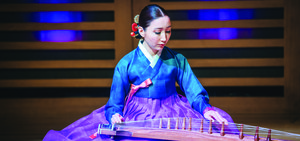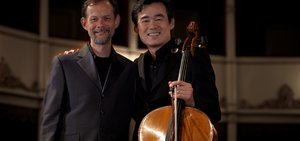Korean Sounds - East Meets West: Series 5

KOREAN SOUNDS - SERIES 5 - East Meets West
K-MUSIC FESTIVAL 2016: KOREAN SOUNDS: SERIES 5
- East Meets West
Wednesday 12 October 2016, 7.30pm
Kings Place, Hall 2 (90 York Way London, N1 9AG)
Artists:
Members from the Korean National Gugak Centre: Hojin Lee (Piri - double-reed oboe), Sunkoo Kim (Haegeumn- fiddle-like string instrument), Chungwhan Kim (Daegurm - bamboo transverse flute), Hyungsoo Kang (Janggu – double-headed drum)
Members from The Royal Philharmonic Orchestra: Sulki Yu (Violin), Chiao-Ying Chang (Piano), Han Kim (Clarinet)
Korean Sounds: East Meet West returns this October as part of London’s festival of Korean music, K-Music 2016. This concert series presents a rare opportunity to hear traditional Korean and classical music in one place. The main focus of this concert lies in the contrast between Korean and Western wind instruments, bringing together a clarinet and a Piri, Korea’s double-reed oboe, made of bamboo.
Programme
Piri Sanjo
Haegeum Sanjo
Daeguem Sanjo
Interval
Stravinsky Soldier's Tale (Violin, Clarinet, Piano)
Devienne - Sonata No.2 (Clarinet, Piano)
Bartok Contrasts (Violin, Clarinet, Piano)
Part 1
For the first half of the concert, a series of traditional Korean folk songs will be presented by Korea’s National Gugak Centre. The Centre is responsible for touring the great folk artists of Korea, they prevoulsy played at Sadler’s Wells in 2015 when they brought the K-Music Festival to a close. They return to London with a more intimate acoustic performance which focuses on the wind music of Korea. The two main instruments will be the piri (double-reed oboe) and daegeum (bamboo transverse flute). They will play sanjo – a folk-based form of music that allows space to improvise throughout the piece.
About Sanjo
Sanjo is a representative folk music genre and performed solo. It is instrumental music that can express a soloist’s creative interpretation and technique. It is often regarded as the quintessence of the folk instrumental music in Korea. Sanjo usually consists of four to six pieces based on different jandans (rhythmic patterns), and performed for about 50 minutes with a Janggu (double-headed drum) or a Buk (single-headed drum) accompaniment. It begins with a slow tempo and speeds up towards the end. While maintaining the basic modes, jangdan, and musical structure, some sanjo masters can create their own lineage by adding their own taste, interpretations, or improvisations. This is the reason why sanjo has been defined as an ‘improvisational instrumental solo genre.’
Part 2
The second part of the concert will present 3 pieces for the clarinet. The first piece, ‘Soldier’s Tale’ by Igor Stravinsky, will show the clarinet’s ability as a storyteller, as well as Stravinsky’s neo-classicism. The second sonata by François Devienne will explore the instrument’s ability in almost pure classicism. The last piece from this first part, ‘Contrasts for clarinet, violin and piano’ by Béla Bartók, finally magnifies the instrument’s versatility for both solo and chamber music.







